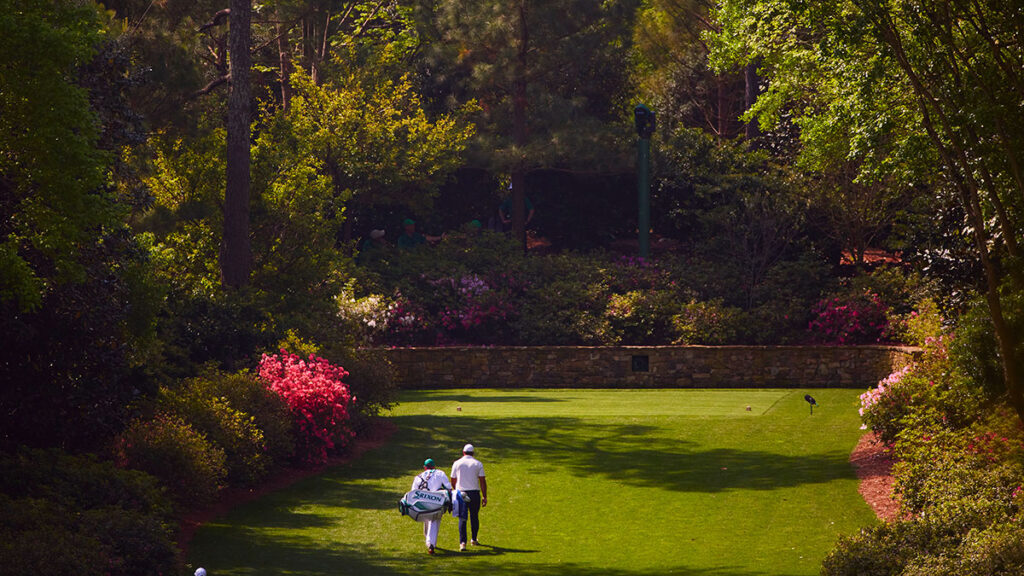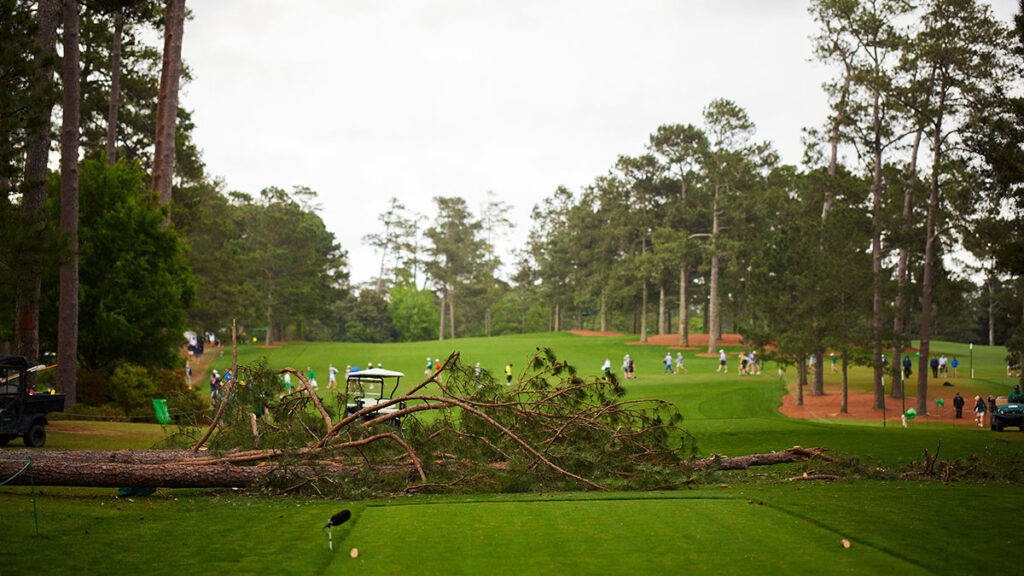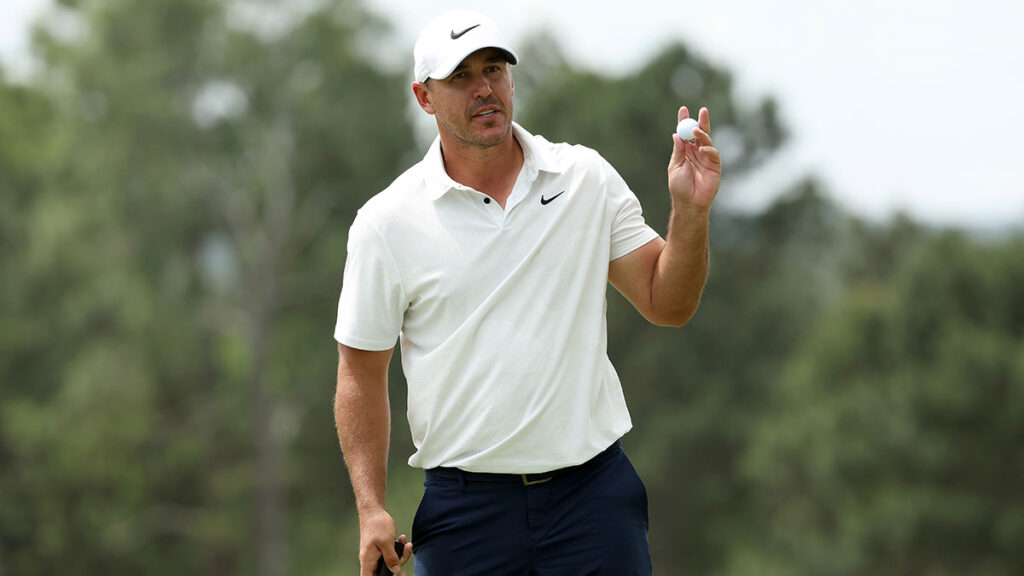The surprising joys of attending the Masters in unsettled times
Today, nearly a year removed from the 2023 Masters, it seems impossible that three Augusta pines fell in front of the 17th tee and didn’t find any of the thousands in attendance on that windswept, knife-grey Friday afternoon. One woman was caught between them, where she stood frozen to the spot, able only to cover her head with her hands, and even she escaped unscathed, like Buster Keaton finding the open window in a collapsing house. The dark humour that follows near-misses was as instant as the relief: maybe, someone joked, she was afraid of breaking Augusta National’s policy against running.
By first light Saturday, the fallen trees had disappeared, removed by an army of workers who had fired up their chainsaws before Friday’s crowds had finished filing out. The craters left by their upturned root beds had been filled and levelled and covered with green wood shavings, rendered invisible to anything less than close inspection, and every pine cone and needle had been picked up as though with tweezers. The only remaining sign of the trees were the impressions their trunks had left on the rain-softened ground.

It was a sobering lesson in expendability. Three Augusta pines had stood, approaching 100 feet tall and straight as ship’s masts, and then for an hour or two they were the world’s most famous windthrow, and then they had evaporated from some of golf’s most sacred territory in the middle of one of its most storied tournaments, and all of it had happened so quickly and discreetly that it was possible to join the gallery in the thin haze of Moving Day morning, stand in the spot where hours before people had fled for their lives, and wonder less at the fine line between life and death than the one that separates memory from dream.
Visiting Augusta National for the first time had been disquieting already. It’s strange to know your way around a place you’ve never been, to recall events in sharp relief that you didn’t witness. Your first day at Augusta won’t give you a daylong case of déjà vu, exactly. It will leave you with a beautiful ache, a bittersweet mix of gratitude for having arrived somewhere you’ve always wanted to go and mourning for the different place your imagination has made it. You will feel lucky and sad. You will feel joyous and unnerved. You will feel a sense of community and unbelonging, as though you’ve been in the company of friendly ghosts.
Even for its most famous repeat visitors, Augusta National has an uncanny knack for being familiar and otherworldly at once. “To just look at the golf course, it looks like it’s been here for over a hundred years and hasn’t changed,” Tiger Woods said during his pre-tournament press conference last year. “And each and every year we
come here…”
He stopped, and then he started again. “Everything has changed since I first played here,” he said.
Woods had played the 17th when it still had the Eisenhower tree. He can close his eyes and remember curling shots around an obstacle big enough to have been named for a president but is no longer there.
Soon the same hole would have three fewer trees. The suddenness of their absence would make Augusta National feel even more like a place that always was and never could have been.

Some people will tell you that the single best thing about Augusta National is the pimento cheese sandwich, still sold wrapped in green plastic for $1.50. Those people are lying to you, and you should never trust them again. The pimento cheese sandwich isn’t even the best sandwich on the grounds. That would be the Georgia peach ice cream sandwich, Heaven’s dessert.
No, the single best thing about Augusta National is the enforced absence of mobile phones. It is a glorious directive, made greater for how fanatically it’s enforced. A patron wearing his cap backwards will be asked to turn it around, sir, please and thank you. A patron who pulls out a phone will never be seen again.
Not a lot about the Masters can be described as quaint anymore. Were it less perfectly managed, today’s Augusta National would feel a bit like a golf-themed amusement park. Instead, it stands in testament to how smoothly something can run if you throw bottomless resources behind it. Three trees can fall, and overnight every other tree on the course can be checked for its stability, allowing golf to be played the next day, largely commercial-free for the good folks back home.
Reporters used to bang away at typewriters in a Quonset hut with a corrugated tin roof. Now they walk up a double staircase in a 30-foot-high atrium to make their way to a gorgeous amphitheatre with a panoramic view of the driving range and enough brass to instrument an orchestra. It’s worth spending an hour in the similarly new and expansive gift shop to marvel at the excess. Last year, there were whispers one man spent $US36,000 on souvenirs and didn’t walk out with that many bags.

Luckily, the caretakers of Augusta National have made enough nods towards its former quaintness to bulwark the romance of the place: manual leaderboards maintained by old men on ladders; white coveralls on the caddies and green jackets on the winners; affordable food and a host of unfailingly lovely volunteers only too happy to help; unforgettable, untouchable Magnolia Lane.
However, when it comes to keeping today’s Masters feeling like the Masters of yore, the phone policy might be the best of their firmly held lines. You’ll probably approach Augusta National along Washington Road. One moment, you’ll be stuck in traffic, threading your way past the Arby’s and Olive Garden. The next, you’ll cross through a towering hedgerow into a small, self-contained universe where, for the first time in decades, you’ll feel a strange serenity, and it’s because you won’t see a single person doing something stupid on a phone.
Imagine what that single policy necessitates of you, and so makes possible for you. Without a phone, you will have no way to tell time, unless you remember to wear a watch. (Commemorative watches are available in the gift shop if you feel the itch.) You will spend hour after blissful hour in the moment. You will know your way around innately, but if you need assistance, you will have to ask someone for directions or consult a paper map. If you want to separate from your companions, you will need to pre-arrange your rendezvous, the way you once made playdates. You will not really know what’s happening on the course except for the history that’s unfolding directly in front of your eyes. Augusta National’s famous roars will alert you to nearby greatness, but until an old man climbs a ladder, you will have to endure a thrilling wonder.
Most important: everyone around you is head up, shoulders back, face forward; everyone around you is available for amiable conversation to pass the time between groups; everyone around you is watching golf without filters or obstructed views; everyone around you is engaged in the world around them, determined to take everything in before they, or it, must go.

Gary Player held his own press conference after he hit his ceremonial tee shot last year. Woods had already made his observation that Augusta National has become golf’s Ship of Theseus, and the subject of change was in the air. Player speaks in prophecies and pronouncements, and not surprisingly, he offered a short, emphatic declaration on the subject: “Change is the price of survival,” he said, and then he banged his invisible gavel.
Golf is in the middle of a seismic period. The distance debate has gripped it for years, perhaps forcing golf-ball rollbacks now that the courses themselves, including Augusta National, have nearly exhausted their own elasticity. Last year, the tee for the 13th hole was moved so far back, it was hard to see the players make their drives. The year before, the 11th wasn’t just made longer; trees were felled (on purpose, this time), and the pond was expanded, too. Woods was feeling unsettled because he had hit the mental tipping point that comes after a certain accumulation of small changes. Even at Augusta National, increments can multiply into something dramatic, and suddenly you’re walking on the moon.
Now, the LIV revolution is also in full throat. Jon Rahm, last year’s Masters champion, won “on behalf of the PGA Tour” when he came from behind to beat defector Brooks Koepka. In 2024, Rahm will defend his title as one of them.
On bad days, it can feel as though a good walk spoiled has become a good sport ruined. Or maybe Gary Player is right: nostalgia is a limiting, even dangerous exercise. Player’s allergy to it probably stems in part from his growing up in Apartheid South Africa; for him, the past has been something to escape, not embrace.

Sentimentality is equally fraught in the American South, where every pining for “how things used to be” demands more than a little specificity. Wishing Augusta National was the way it was risks side-wishing for the return of unimaginable sin. Jackie Robinson broke Major League Baseball’s colour barrier in 1947. Lee Elder couldn’t integrate the Masters until 1975; the club’s all-Black caddie corps worked the tournament exclusively until 1983; Ron Townsend, the club’s first Black member, wasn’t admitted until 1990. Augusta National’s galleries remain overwhelmingly, unnervingly white, but it says something about forgiveness – or selective blindness, at least – that the Masters still occupies the place in American society that it does. If things hadn’t changed, right about now someone would be burning the clubhouse to the ground.
So, when you finally get there, and you’re feeling a little melancholic about what you thought you’d find at Augusta and the modern realities of the place, maybe make the long, circuitous walk to the tee at the 11th. It’s Augusta’s Idaho: not on the way to anywhere, but worth the detour if you’re in the mind for reflection.
It’s quiet back there, quieter than just about anywhere else on the course. You’ll be able to secure a spot right against the ropes, and great golfer after great golfer will appear before you as though they are on your time, not theirs, and lace fizzing drives that you can follow into the sky, framed by the trees and the slope. It will feel like they are performing for you and only you. Here, they will say. Watch what I can do.
Then, after you have had your fill of watching some of the last pre-rollback golf balls being obliterated, follow one of the groups down to the green, and wade into the great mass of humanity that has assembled at the apex of Amen Corner. See the reflections of the colourful crowds in the oil-black ponds. Watch golfers make one of the fantastic walks of their lives over the Hogan Bridge. Close your eyes and listen to the buzz of anticipation, followed by the rhapsody of result. Then open them again and take a moment to remember where you are, lucky to be alive when so many are ghosts.

If life is a matter of perspective, golf is a game of choices. Some people watch the Masters by following their favourite golfer or group; others stake out a daylong spot at the first tee or on the rise by No.12 or in the bleachers at the 16th; a few wander and stop and wander again, following roars and instincts. If your first day at Augusta National happens to be a Sunday, however, your choices will be narrowed until you have only one: to watch the tournament come to its end, and so bear witness to one of America’s most magnificent assemblies.
As the morning turns into afternoon, and as groups finish and depart, there is less and less golf to watch, and folks start funnelling towards the final hole like mercury finding the drain. If you hang back a little and watch the scene from a distance, as though you’re a battlefield general surveying the movement of armies – the by-then empty eighth fairway will be a good spot – you will forsake a close-up view of the winner’s final putt. In exchange, you will watch thousands of people make a pilgrim’s walk to watch another man’s life change forever. If the light is right, which it probably will be, and if the temperature is right, which it probably will be, you’ll forget your laments and misgivings about what the Masters and golf and maybe America have become, and for a few sweet minutes you’ll feel good about their shared possibilities again.
Last year, some members stood on the clubhouse verandah, drinking lemonade, watching Rahm make his walk to the green. Their eyes were half-closed, shielding themselves from the low sun’s blinding light. “You can’t have a day like today without a day like yesterday,” one of them said. He was talking about the weather, which had been stormy on Saturday, too, although not nearly blustery enough to knock over more trees. He could have been talking about our present and our past, the way our paths have combined to lead all of us here, together, and how tomorrow will change depending on how we live today.
Way back on Tuesday afternoon, before another tournament’s worth of memories had been laid on top of Augusta National like a blanket, an older woman had stood admiring an enormous tree left of the ninth tee.
She was there with a younger couple, wearing matching Masters-brand golf shirts, fresh from the gift shop. The couple had ridden all the rides, and they stood listless and maybe a little bored, as though they didn’t know what to do next.
“Aren’t you amazed by it?” the older woman asked, ducking under the branches to get a better look at her tree, ancient and beautiful.
The couple didn’t answer.
The older woman looked across at them and then looked back up at her tree.
“You should be,” she said.
Photos by: Ben Walton; Getty Images: Patrick Smith



